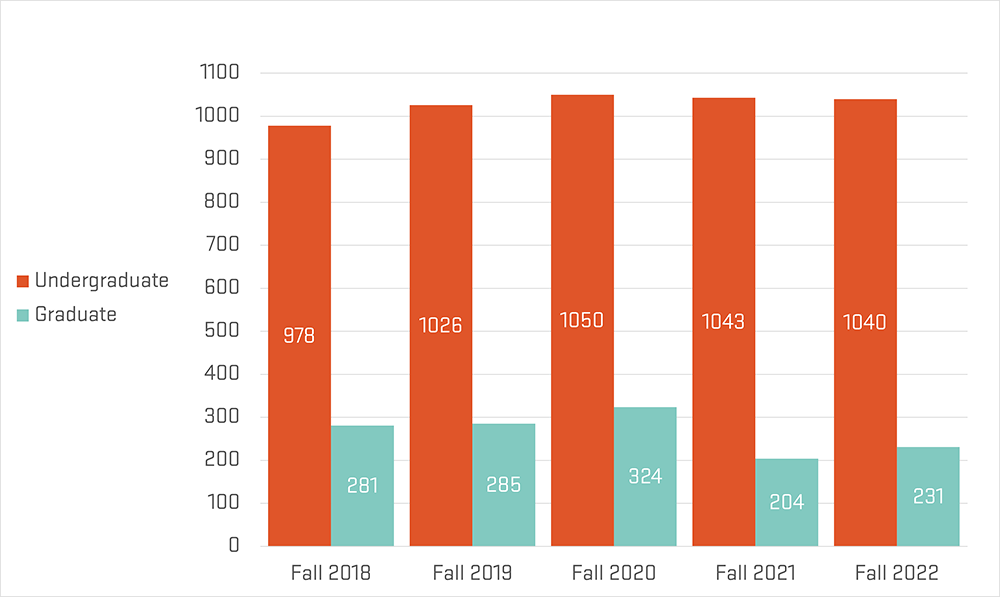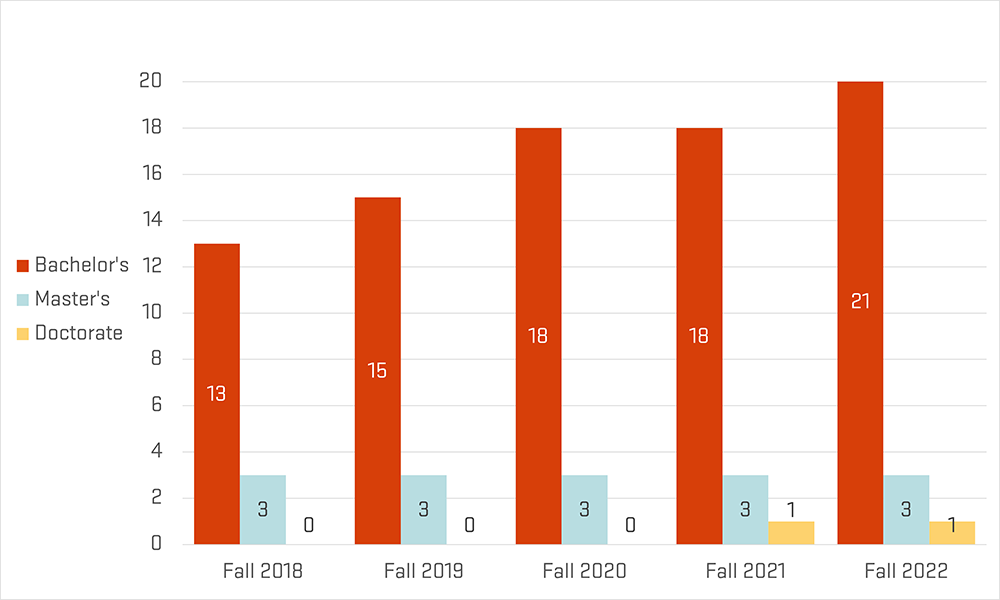Fiscal Years 2018-2022
OSU-Cascades monitors progress in 24 key areas that represent student enrollment, student success and retention, graduation outcomes, degree programs, research, philanthropy, diversity, building energy use, as well as in the financial health of the campus. This information is updated each fiscal year.
ENROLLMENT
Enrollment data are based on the annual enrollment report, released the fourth week of each fall term.
Total Enrollment

Degree Level

New Student Enrollment (Recruitment)
Note: Fall 2021 data have been revised to reflect degree-seeking students, consistent with other years' reporting.

Student Residency

Students from Central Oregon
Students from within Crook, Deschutes or Jefferson counties.

First Generation Undergraduate Students
First generation undergraduate students are the first in their family to attend college or a university.

Student Ethnicity
Student ethnicity is self-reported.

Student Age

Students Living on Campus
The residence hall, completed in 2017, has occupancy for up to 300 residential students.

STUDENT SUCCESS
Student success is measured by retention and graduation rates, and graduation outcomes.
Undergraduate Experiential Learning

One-Year Retention Rates
Most students are retained at OSU-Cascades, while some continue their education elsewhere within OSU.

Graduation Rates
Most students complete their degree at OSU-Cascades, while some finish elsewhere within OSU.

Graduation Outcomes
Alumni employment is based on an annual survey of graduates six months after graduation. Data are from the 2022 survey.

ACADEMIC PROGRAMS
New degree programs are determined based on student demand, an understanding of industry needs and a survey of other university’s offerings.

Average Class Size

RESEARCH AND INNOVATION
A growing research enterprise is attracting federal and foundation funding for projects that address local and global challenges.
Research Expenditures

FUNDRAISING AND ENGAGEMENT
Philanthropic, community and alumni engagement accelerate OSU-Cascades' mission to provide globally-relevant education, research and outreach, and produce talented and career-ready graduates. Fundraising is made possible through a partnership with the OSU Foundation.
OSU-Cascades Endowment
The OSU-Cascades endowment was created as a promise to future generations of students and faculty. It supports many important initiatives at the Bend campus such as making a university education more attainable through student scholarships, ensuring teaching excellence through endowed faculty positions, and other key programs.

Donor Gifts
Donors to OSU-Cascades include community members, businesses and foundations, and alumni. They support student scholarships, faculty scholarship and teaching, and the campus capital needs as it expands to serve 3,000 to 5,000 students.

Community Event Attendance
Events include a Science Pub lecture series, guest lectures and other events for community members. Basis for tracking data has been updated to count registered unique individuals instead of estimated gross cumulative attendance.

FACULTY AND STAFF
Faculty Demographics

Staff Demographics

CAMPUS FACILITIES
The expansion of the OSU-Cascades to a 128-acre campus serving 3,000 to 5,000 students will occur over several decades. Future construction is determined by and dependent upon student enrollment growth and state capital funding.
Expansion Status
The campus master plan will be executed in phases.

Building Energy Use
Energy use is monitored in buildings and will be studied as OSU-Cascades pursues its goal to achieve net zero energy usage throughout the campus.

CAMPUS BUDGET
The OSU-Cascades operating budget is determined annually and primarily based on revenues received through the state general fund, and student tuition and fees. It is approved by the OSU Board of Trustees.
Operating Budget
